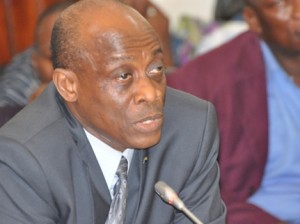Energy sector levies are temporary – Terkper

The Minister of Finance Mr Seth Terkper has said that the recent energy levies and some of the new taxes that have been introduced are temporary and only part of the structural changes of the economy’s correction process.
“When you are doing a correction, there are certain taxes which you use for the correction as you cut expenditure, but they don’t remain; you don’t allow them to remain,” the minister said, adding that the energy levies, the fiscal stabilization levy, and some import duties would later have to go away.
The Finance Minister told journalists, the recent energy sector levies are to clear the debts of state-owned enterprises in the energy sector that have encountered serious financial challenges, such as the Volta River Authority (VRA) and the Electricity Company of Ghana (ECG), and to improve their viability.
The levies would be used to control their debts and to unlock receivables that are currently being hindered.
President Mahama during a press conference last month, also indicated that the VRA is currently indebted to virtually every bank in the country and that is why government is taking advantage of the fall in oil prices, to tax for the much necessary clearing of the debts.
“We are going to use the receivables and the levies to clear the debt, strengthen the balance sheet and improve collection from me and you to make sure that when we use the power we pay for it,” Seth Terkper said.
He emphasized that debt financing and the financial viability of these institutions would be key to the expansion of power generation and closing of the generation deficit, using gas coming from the development of the TEN fields and the Sankofa gas project.
The Ghana National Petroleum Corporation (GNPC) is going to be the off-taker for gas from the Sankofa project and would be the supplier of gas to the Ghana National Gas Company (GNGC), the Volta River Authority and other independent power producers (IPPs) for domestic power generation.
The monumental Sankofa gas project which is expected to add up to 1,000 megawatts to Ghana’s power generation capacity, is covered by a partial risk guarantee of $500 million (the largest ever) by the World Bank, for the non-payment of gas bought by the GNPC.
Terkper noted however, that government must try to avoid falling on the guarantee, which would be a new liability should it be activated, hence the ongoing reforms with the ECG such as prepaid metering.
“It is important that ECG is in a position to collect our bills and pay for the power, in order that backwards, they pay VRA, GNGC, IPPs, and backwards again, they will be able to pay GNPC. If we cannot do that we cannot sustain that gas which is coming on stream,” he said.
By Emmanuel Odonkor
